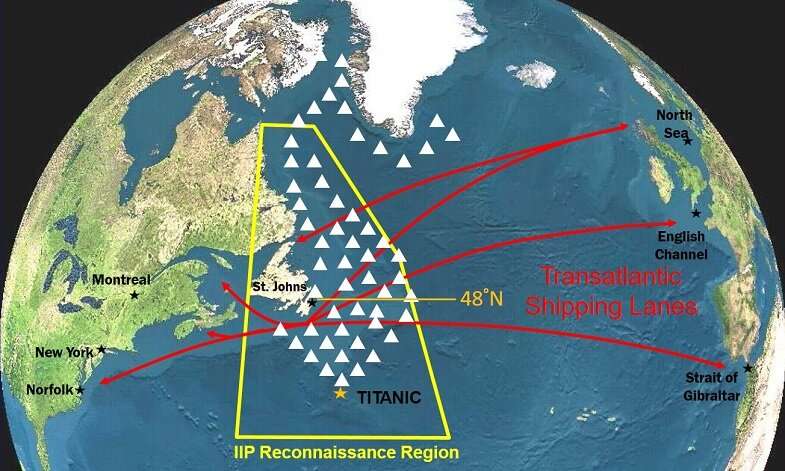Artificial intelligence helps experts forecast icebergs

This year will see a relatively low number of icebergs drifting into busy shipping regions in the north-west Atlantic, according to a combination of control systems and artificial intelligence forecasting models developed by experts at the University of Sheffield.
A recently published control systems model has been used to predict that between 479 and 1,015 icebergs will reach waters south of 48°N—the area of greatest risk to shipping traveling between Europe and north-east North America—in 2020, compared with 1,515 observed there last year.
In an innovative new model approach, the team have used experimental artificial intelligence analysis to independently support the low iceberg number prediction while also predicting a rapid early rise in the number of icebergs in this area during the ice season of January to September.
The findings are supplied to the International Ice Patrol (IIP) to inform resource use for better regular ice forecasts during the season. The seasonal forecast suggests that the probability of an iceberg encounter for ships in the north-west Atlantic will be less than it was last year.
Icebergs have long been a risk to shipping in the north-west Atlantic, with records of collisions and sinkings stretching back into the 17th century. The infamous sinking of the Titanic in 1912 led to the formation of the IIP, which is tasked with observing sea ice and icebergs in the north-west Atlantic and warning shipping of ice hazards.
The iceberg risk varies enormously from year to year, with some years recording no icebergs passing across 48°N while others record well in excess of 1,000—making it difficult to predict, though generally higher numbers have been counted south of 48°N since the 1980s.
This year is the first time experts have used artificial intelligence to forecast the total number of icebergs passing 48°N, and the rate of change in this number across the season.
The model, developed by a team led by Professor Grant Bigg at the University of Sheffield and funded by insurance firm AXA XL's Ocean Risk Scholarships Programme, uses a control systems model and two machine learning tools. These analyze data relating to the surface temperature of the Labrador Sea, variations in atmospheric pressure in the North Atlantic, and the surface mass balance of the Greenland ice sheet. The foundation control systems approach achieved an 80 percent accuracy level when tested against data on iceberg numbers for seasons between 1997 and 2016.
Professor Bigg's earlier research showed that variable calving rates from Greenland largely explain the variability in the number of icebergs drifting south of 48°N from year to year—but the basic driving forces are regional climate and ocean currents. Iceberg and ocean/atmosphere observations suggest that higher numbers of icebergs are associated with colder sea surface temperatures and stronger northwesterly winds.
Grant Bigg, Professor of Earth System Science at the University of Sheffield, said: "We have issued seasonal ice forecasts to the IIP since 2018, but this year is the first time we have combined the original control system model with two artificial intelligence approaches to specific aspects of the forecast. The agreement in all three approaches gives us the confidence to release the forecast for low iceberg numbers publicly this year—but it is worth remembering that this is just a forecast of iceberg conditions, not a guarantee, and that collisions between ships and icebergs do occur even in low ice years."
Mike Hicks of the International Ice Patrol said: "The availability of a reliable prediction is very important as we consider the balance between aerial and satellite reconnaissance methods."
Dr. John Wardman, a Senior Science Specialist in the Science and Natural Perils team at AXA XL, said: "The impact of sea level rise on coastal exposure and a potential increase in Arctic shipping activity will require a greater number and diversity of risk transfer solutions through the use of re/insurance products and other 'soft' mitigation strategies. The insurance industry is keeping a keen eye on the Arctic, and this model is an important tool in helping the industry identify how or when the melting Greenland Ice Sheet will directly impact the market."
Provided by University of Sheffield





















